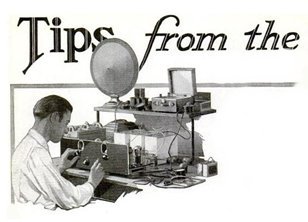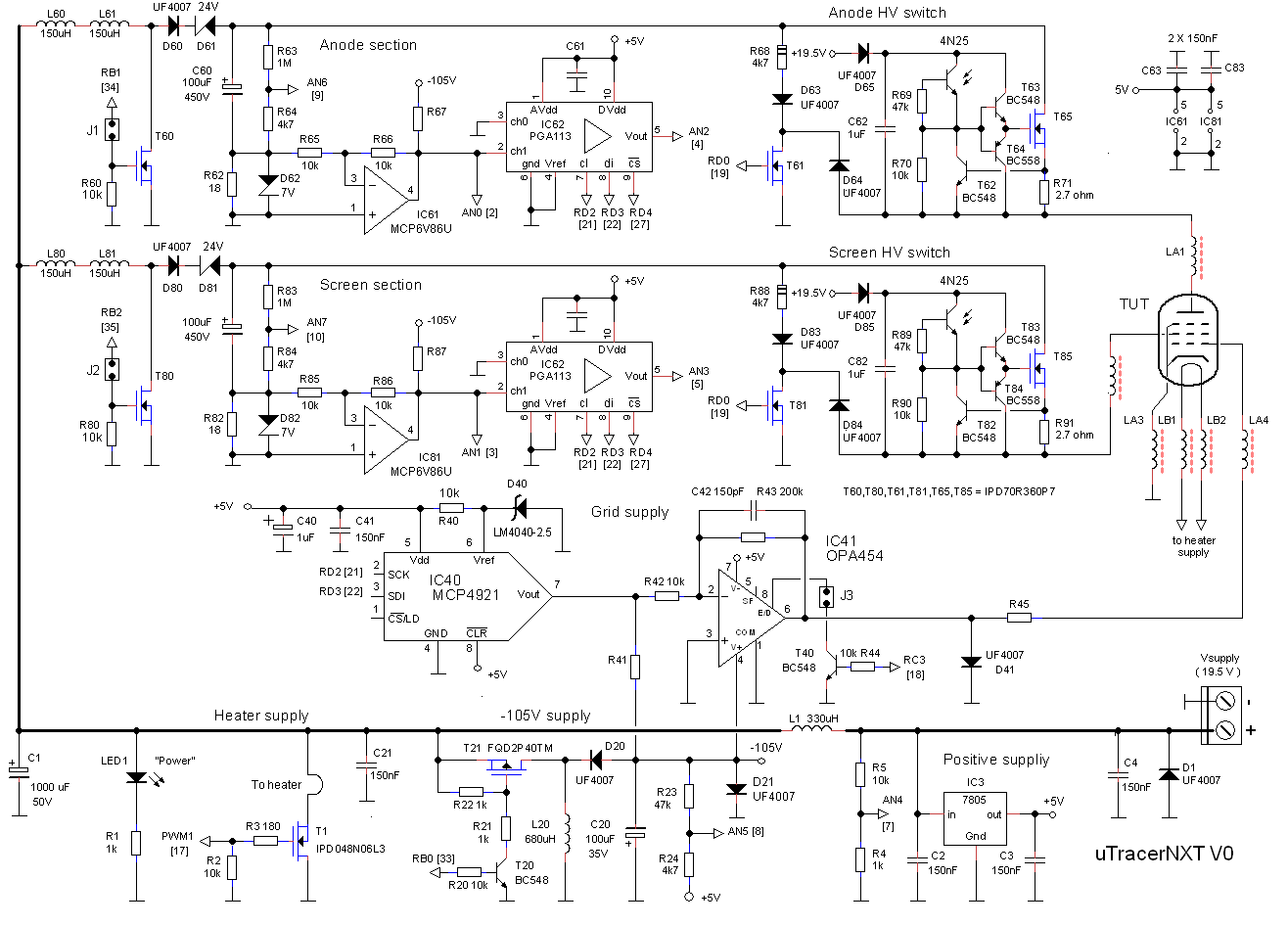 |
 |
 |
 |
 |
 |
|
Contents:
|

|
A bit of history
The first ideas for a pulsed tube curve tracer were conceived as far back as Christmas 2010. The first uTracer version used a high-side current sense circuit that did not really work satisfactorily. After a golden tip from somebody following my weblog, I changed the current sense circuit to its present concept, and the uTracer3 was born. Stimulated by my sons “to go commercial,” I designed a PCB for the uTracer3 in 2012 and later that year the first uTracer kits were on their way to the first customers.
How does such an undertaking work in practice? Of course the first experimental versions of the uTracer were constructed with components I had lying around. With the circuit working very satisfactorily, it was not more than logical to copy the circuit one-to-one for the commercial version of the uTracer3. At the time I estimated that perhaps, with a bit of luck, we would sell a few dozens of kits. I absolute could not have imagined that 12 years later there would be over 2600 uTracers in service in 63 countries!
Over the years, I discovered and experienced things that also real, large compagnies have to deal with. One of these things is that once you have a product running, it is not so easy to make changes to it. Over the years there have been two major changes to the design of the original uTracer. The first major change was the introduction of the uTracer3+ which raised the maximum voltage to 400 V, and the second change was a redesign of the PCB. Every change requires adaptation of the manual, changes in the components to be ordered, the production of a test series to make sure the kit is flawless, etc. Additionally, there is the issue of customer support. The uTracer is a rather complicated kit, and unavoidably mistakes happen during its construction. I always try to help everybody as good as I can via email, and if that doesn’t work out I am happy to have a look at the circuit myself, so you really want to limit the number of circuit versions to deal with to the minimum. In short, the choices you make in the beginning in terms of component selection and circuit topology may very well haunt you for years!

One of the things every electronic appliance company that sells products that run over many years must deal with, is that at a certain moment components become obsolete. It happens to big companies, like Philips where I work(ed), and tiny companies like Dos4ever. At a certain moment for example, it was announced that the original processor, the PIC16F874 would be taken out of production. The PIC16F884 was suggested as an almost pin compatible alternative. Nevertheless, it took me days of headache and many software changes to get it working. Also the original MJE350 and KSP99 high voltage pnp transistors in the meantime have been phased out and had to be replaced with suitable alternatives.
The latest addition to the list of “soon to be obsolete” components is the DIL version of the OPA227! Already since COVID times, the availability of the OPA227 has given me a headache, while also since that time its price has skyrocketed! Apparently the SMD/SMT version of the OPA227 will remain in production somewhat longer, so to mitigate the upcoming problem, my first idea was to redesign the PCB to make it suitable for the SMD variant. However, thinking things over I started doubting if this would be the right way to go?
I have always been a strong fan of “old fashioned” through-hole components. Primarily, because most uTracer customers are tube/valve enthusiasts who, very often, do not have much affinity with tiny, fragile, difficult to handle and solder SMD components. Secondly, I always had the idea that servicing a circuit with through-hole components was easier than servicing a PCB with SMD components. I learned that although this certainly holds for IC’s in sockets, where the possibility of rapidly exchanging a part helps to quickly debug the circuit, I discovered that the situation may be completely the opposite for other components. Ever since I started using a hot air soldering station, I realized that especially replacing transistors is much easier if you have an SMD component instead of its through-hole counterpart! On top of that, the harsh reality is that many modern and powerful components are simply not available in through-hole packages anymore!
So, all this made me think and decided me not to go for a straightforward simple modification of the uTracer3 PCB, but instead to take a critical look at the whole circuit and come up with a more modern and future proof overhault: the uTracerNXT!
What’s in a name?
Being a man of exact science (and a bit autistic as well), my first idea was to name the redesign of the uTracer the - you may have guessed it - uTracer3.2. However, after hearing me talk about the uTracer3.2 for weeks, the CEO of our tiny family enterprise (my wife) expressed her discontent with the name. First of all, she thought it looked “ugly,” but she also thought that it was rather nondescriptive, not doing justice to the fact that the new design will also include a substantial number of innovations and improvements. “It’s a bit how kings or popes are numbered” was here objection. Since we already have a uTracer 4, 5, 6, 7 (that not all made it into a kit by the way) I started thinking of an alternative. For a moment I was tempted to call it the “FU2Tracer,” but I am glad I was sensible and didn’t go that route. Playing with words and letters I came up with NXTracer (Next Tracer) to emphasize that the new tracer is not just an upgrade of the old uTracer3+, but really a completely new design. However, then several readers pointed out to me that it would not be a good idea to discard the, in the mean time, well-known brand name uTracer (micro-Tracer), so in the end we settled for uTracerNXT, to be pronounced “Micro-Tracer Next” I tested the new name on my wife and sons, and they all liked it. So, there we have it, the uTracerNXT!
uTracerNXT wish list
Producing more than 2000 uTracer3+ kits, servicing them and getting feedback from users and adding to that new ideas and insights gained from the uTracer6 and the stillborn versions 4 and 5, resulted in a wish-list for the uTracerNXT.
New features / Modifications:

| to top of page | back to uTracer homepage |
Figure 2.1 shows a first plan for the analog circuit part of the uTracerNXT. It is by no means a definitive version, but rather a first draft to start working from. In the circuit many of the learnings gained from the uTracer6 but also the work on the uTracer7 have been implemented.
Going from the top to the bottom, the first two “rows” of the schematic as usual depict the anode and screen high-voltage supplies and switches. One of the changes in the uTracerNXT with respect to its two predecessors is that the cathode of the tube is referenced to ground rather than to the + of the supply voltage. The reason for this was that normally the output voltage of a boost converter cannot be lower than its supply voltage. However, by simply adding Zener diode D61 with a breakdown voltage higher than the supply voltage in series with high voltage blocking diode D60, allows the output voltage of the boost converters to go down to 0 V. The potential penalty for this trick is a little but lower efficiency, but we will have to see how serious that is.
Moving to the left, the “normal” diode in parallel to the current sense resistor R62 has been replaced by a Zener diode. The idea is that during the charging of C60 the Zener diode is conducting, just like a normal diode, and that during discharging – that is the measurement pulse – the Zener diode is in reverse bias and in that way protects OpAmp IC61 for high input voltages, e.g. during a short circuit at the output of the anode supply. The circuit around the current sense OpAmp and the PGA IC62 is pretty standard, with the exception of resistor R67, which sinks a small current from the output of the OpAmp to the negative power supply. The idea is that this will help the output of the OpAmp to really go down to its negative supply line, 0 V. The reason is that although most OpAmps these days are advertised as having rail-to-rail outputs, what really is meant is almost rail-to-rail. More in this the next section.
The high voltage switch is identical to the circuit used in the uTracer6. The circuit is extensively described in the uTracer6 weblog. At the writing of this page, there are more than 500 uTracer6 in service in 49 countries. So far, not a single failing high voltage switch has come to my attention. For me reason enough to copy the circuit one-to-one for the uTracerNXT. The only change is that the 1000 V STD2NK100Z NMOS transistors have been replaced by the readily available 700 V IPD70R360P7. As usual the screen circuit is identical to the anode circuit.
Moving down to the bottom part of the circuit, we find the heater, negative grid bias power supply and the +5 V power supply. Missing here, compared to the uTracer3 and 6, are the +15 V and -15 V power supplies, which saves a lot of overhead. The -105 V negative grid bias power supply uses a -400V FQD2P40 PMOS transistor instead of the BD138 pnp transistor in the uTracer3, which I expect to result in a more reliable operation.
Similarly, the grid bias supply also follows the design used in the uTracer6, be it with different components. A LM4040 “Zener” diode, provides a stable 2.5 V reference voltage to the DAC. As DAC the readily available 12 bit MCP4921 from MicroChip is used. The MCP4921 is programmed via a serial SPI bus, and by using the onboard 2x amplifier, the output voltage can be programmed to be between 0 and 5 V. An OPA454 High-Voltage OpAmp from TI is configured as a 20x inverting amplifier which boosts the output voltage from the DAC to a voltage between 0 and -100 V. Just like in the uTracer6 I intend to use the grid bias in pulsed mode by means of T40 to limit the power dissipation in the OpAmp, especially for conditions where the output is for some reason short circuited. The reason I plan to use an OPA454 is because it seems to have a better availability than the LTC6090 from Analog Devices used in the uTracer6. D41 and R45 protect the OpAmp against flashovers in the tube and short circuit conditions.

Figure 2.1 First tentative draft of the (analog part) of the uTracerNXT circuit. For this circuit diagram I used the schematic of the uTracer6 as starting point, so component numbering may be inconsistent.
| to top of page | back to uTracer homepage |